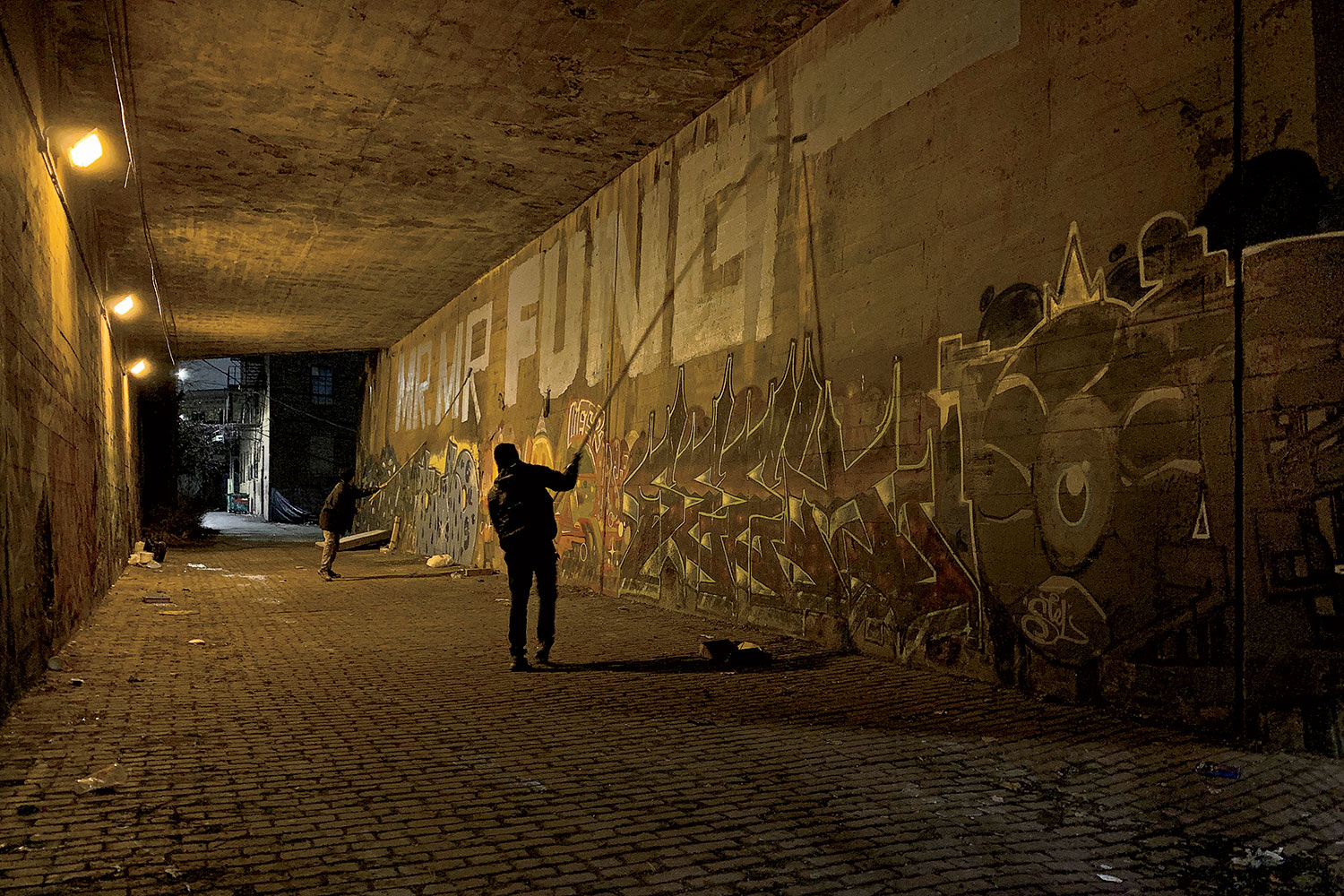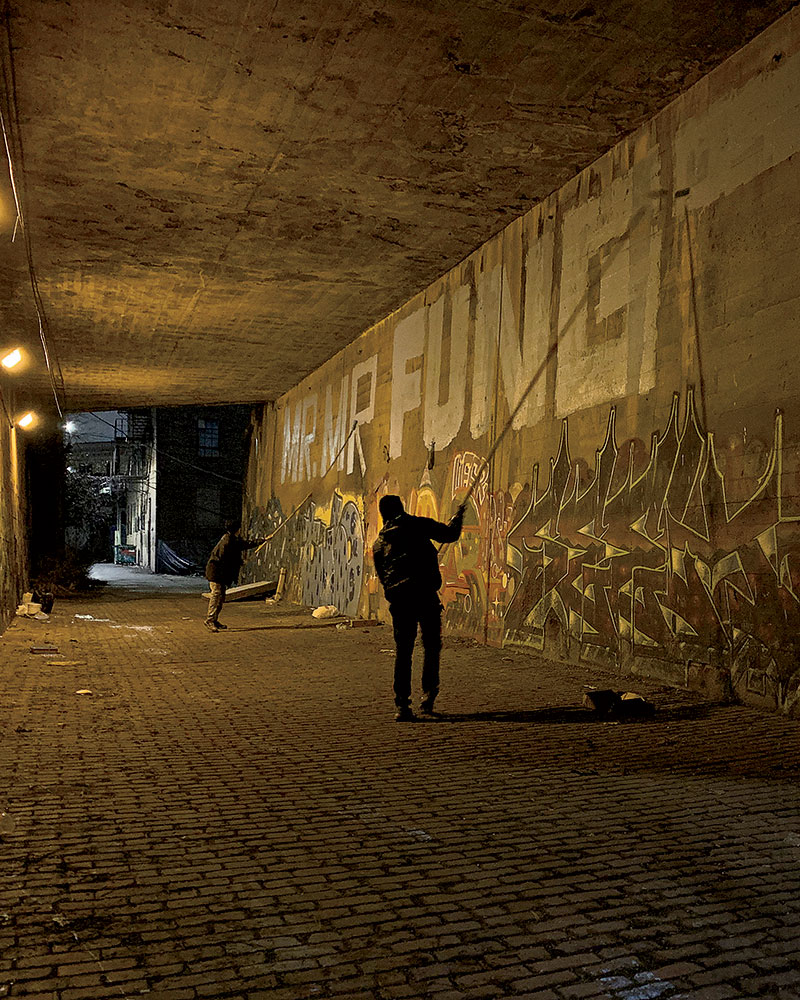The videos I’ve been pouring over are dark and grainy, with quick cuts of light, the fast wheeze of paint followed by the clanging of the metal ball against the can. It’s also how I feel as I try to write this story — in the dark, with brief glimpses of what it is I’ve been seeking for months. A tease of revelation, then a shuttering of the light.
Since the beginning of last summer, I’ve been looking for Mr. Mr. Fungi — or rather, the person who scales buildings, overpasses, and bridges around Chicago, painting “Mr. Mr. Fungi” in massive block letters on brick or windows or the concrete framing the expressways.
One night, my husband comes home from a meeting and shows me his phone. “Look what I found,” he says, flashing a photo of “Mr. Mr. Fungi” plastered across a warehouse on the river, near Bridgeport. The windows on the river-facing wall are dotted with the word “fungi.”
The name is formal (Mr.), but irreverent (Mr. Mr.), with a sense of whimsy (Fungi). It’s everywhere: at the intersection of Irving Park and Western, a blur on I-90 East as I drive downtown. Letterforms, six to 10 feet high, spaced with precision, dangling above the movement of the city on high-rises and highwayscapes.
“Yeah! I’ve seen that around town. Who is this guy?” is the common refrain whenever I bring up Mr. Mr. Fungi to my friends and colleagues. So I Google him (or her, or they). The search results show a Reddit discussion thread, a collection of images featuring “Mr. Mr. Fungi” tags from amateur urban landscape photographers, and an article about a 2016 arrest in Berwyn of a graffiti artist who was charged with defacing property with “fungi” but without the “Mr. Mr.” The results quickly devolve into articles about beautifully rendered murals of mushrooms.
I start with the Reddit thread and, to my delight, find a community of people who share my curiosity. There’s another image, a link to the article about the Berwyn arrest (“Do y’all think this is the same? Looks like similar writing style”), and mentions of locations where folks have spotted a “Mr. Mr. Fungi”:
Lord_Poop1: Yea, there’s one at an abandoned hospital near my school and recently passed one earlier today. And that was my second encounter with it.
theYoungNilo: He climbs his way up to some crazy places. I just saw a fresh one on my way home on the BNSF.
Antique-Campaign3489: i see his tags all over the city i stg.
I also see a comment from Fatpregnantlady: “Fungi has an Instagram @fat.pregnant.lady.” I immediately click the Redditor’s name, hoping to see what else the user has posted — something that might establish credibility or give me a sense of who this person could be. Instead, I’m taken to a page that tells me the account has been suspended by Reddit.
There’s nothing left to do but find @fat.pregnant.lady on Instagram. The account is private. I request access. The profile photo is a face that looks like a skull with skin dripping, empty eye sockets, and mouth agape with blood streaming out. I wonder what it looks like to receive my request: a black-and-white photo of a woman with a bob blowing a bubblegum bubble, my feed filled with saccharine pictures of my family, of my child, of a life that, on the surface, seems radically different from that of someone posting a melting skull screaming into the void.
I don’t know if my request will be accepted. Tagging is, of course, a clandestine activity, and Chicago’s relationship with graffiti and graffiti artists is fraught. Strangers asking for a peek behind the curtain might be quickly dismissed.
In 1992, the City Council approved an ordinance that effectively banned spray paint sales within the city in an effort to curb graffiti vandalism. Following an unsuccessful challenge that made its way to the U.S. Supreme Court in 1995 after an emergency request from spray paint makers and sellers, the law went into effect. If you’re surprised by this because of the continued proliferation of graffiti around town, the federal judge who had previously declared the ordinance unconstitutional, concluding a ban would have “no deterrent effect whatsoever” on graffiti, would agree with you. (In 2018, Alderpersons Matt O’Shea and Ed Burke coauthored legislation that would have lifted the ban, allowing anyone over 18 to buy spray paint in Chicago, but it was sent back to committee.)
There’s nothing left to do but find @fat.pregnant.lady on Instagram. The profile photo is a face that looks like a skull with skin dripping, empty eye sockets, and mouth agape with blood streaming out.
A few days after I click the blue “Follow” button, @fat.pregnant.lady accepts my request, and I spend my scrolling hours trying to determine if this is the person responsible for the tags. There are photos of them in this person’s feed, but more interesting is how @fat.pregnant.lady, who I can now see is actually a guy, seems to spend his days, as documented in his Instagram stories. On June 13, he drives somewhere to pick up a free organ that was listed on Craigslist and donates it to a retirement home for the dementia patients to play. On June 19, he posts about his flock of quail spending its first night outside. The same day, he reposts a picture that someone has taken of a sign at Owl Canyon, inside Starved Rock State Park, enhanced with a few choice letters to read “Smoke a Bowl Canyon.” “I did that,” he writes.
Throughout the summer, I watch as he builds mannequins from found objects, arranging them in strange tableaus in what I assume is his apartment. One, headless and made mostly of saran wrap and formed around what looks like a wire and wood structure, leans against a wall, arms dangling to its knees. Another one, much smaller, wears a hoodie and hunches over without the support of anything. Its hands seem to be made out of masking tape.
At the beginning of August, I muster up enough courage to reach out via an Instagram DM. Would he want to talk? I add that I like his cat, an entirely on-brand hairless sphynx.
“I would be interested,” he replies after a few hours. “Mr. Mr. however is another individual.”
My heart sinks. I’m disappointed but not surprised to learn that this isn’t the artist I’d been chasing. From what I’ve observed, @fat.pregnant.lady seems unreliable at best. Like the kind of guy who wants to subvert the system, to live outside societal norms. Why should I expect him to be honest in a Reddit thread?
One afternoon, looking for new leads, I ask Nikko Locander, a.k.a. Ali Six, about Mr. Mr. Fungi. Now a street artist who paints legal, often commissioned murals around Chicago, Locander started dabbling in graffiti in high school before ultimately joining Air Crew, a group active in Pilsen. He suggests that I try to determine whether Mr. Mr. Fungi runs with anyone. “If you see their tags next to someone with the same color or hand style, find out who that person is, if that person is in a crew,” he says.
From what I gather, crews offer a sense of belonging, a chance to be a part of something bigger and to refine your skills. Some kids start their own crews with friends in the neighborhood; others join a crew that’s established. There are territories, there are rules of engagement — where you can tag, where you can’t — and there is camaraderie. “Being around other like-minded people with the same skill level, you see people working with their different style,” Locander explains. “There’s this guy named Obie. When we’re working on a wall, he’s teaching me how to create this certain effect because he’s a wizard.”
But it takes time to join a crew. Persistence, practice, proving your dedication. “It doesn’t happen automatically,” Locander says. “You have to elevate your style from good to great. A crew won’t automatically accept you.”
The arc of a graffiti artist’s career, according to Locander, starts with “little shitty tags,” then progresses to nicer tags, to “fills” (filled in with color), to “pieces” (short for “masterpieces”), to “burners” (larger, more elaborate pieces that are so good they burn everything else around it), to cartoon characters. For many graffiti artists, the final step is transitioning out of that scene into a world that accepts what they do as art and allows them to put their names on the pieces they create, make money, and speak on the record to curious reporters.
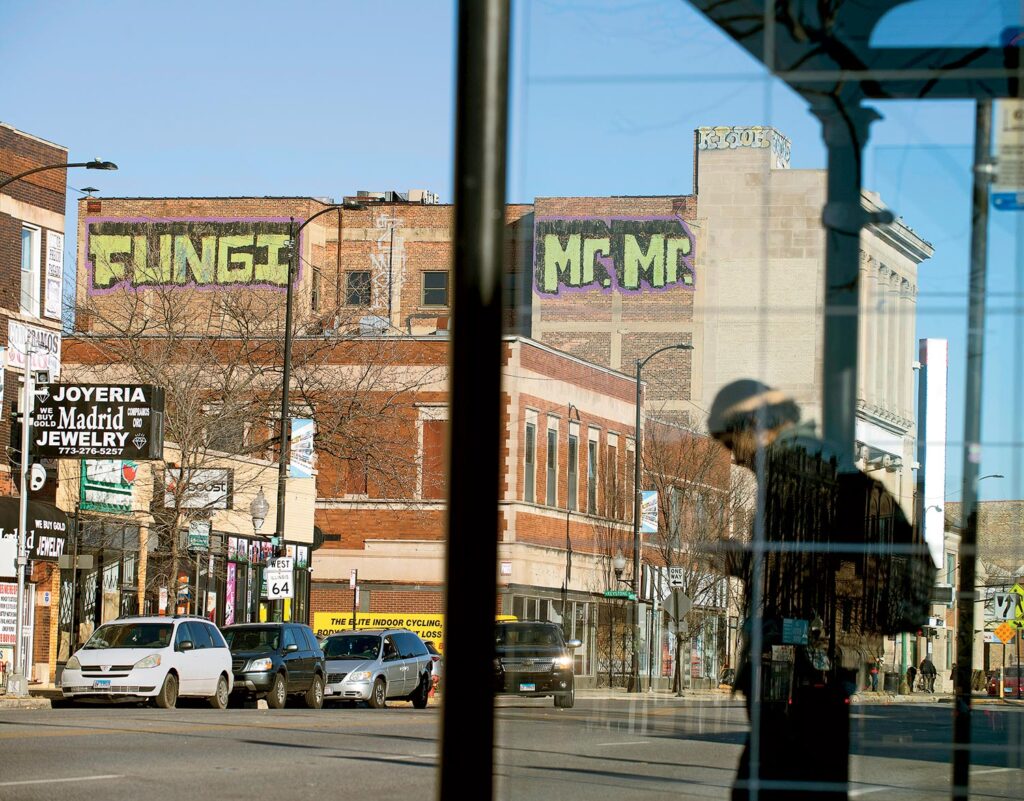
It relates, in some ways, to what I’m trying to do: elevate the art form, provide a platform for the artist, for Mr. Mr. Fungi. But is this also the problem with my approach? I’m relying on my own interpretation of what I see as art: strong typography, well-spaced lettering, an understanding of color and motion. Something that speaks to conventional talent and artistic sensibility. That’s not how many of Locander’s former peers see it, though. “Graffiti artists have a mentality that this isn’t even art,” he tells me. “We’re our own culture — fuck the system.”
A few days go by after @fat.pregnant.lady tells me he’s not Mr. Mr. In the past year, he’s posted photos of someone in a ski mask with a can of spray paint, large block “Mr. Mr. Fungi”–esque letters in front of them. I decide that even if @fat.pregnant.lady is a dead end, he might know who is bombing the moniker around town.
“Would still love to chat. Even if you’re not Mr. Mr.,” I reply, using his same shorthand.
Eight days later, he responds.
“I paint fungi.”
I stare at my phone, suddenly realizing I might have made an incorrect assumption. Of course! What if it isn’t one person I’m looking for, but two? One Mr. Mr., one Fungi. A crew of two.
“We could meet at a coffee shop,” he writes. “What neighborhood do you stay by?”
I know from watching his Instagram stories that he steals online orders from Chipotle. I try to sweeten the deal and offer to buy lunch.
He stops responding.
It’s hard to tell if I should take him seriously. There’s a blatant disregard for societal norms, which I presume would extend into conversation with a stranger. He has no reason to tell me the truth. I assume he wants to mess with me.
After a few days with no response from @fat.pregnant.lady, while looking at a “Mr. Mr. Fungi” in an Instagram photo, I notice another piece in the frame: big, beautiful typography that spells out “Zwon” with an elaborately rendered skull in the place of the o. There’s a handle that’s been tagged — @Zwonster — and I remember what Locander told me about people who tag near one another. They could be friends. Acquaintances. Perhaps, even, part of a smaller, lesser-known crew. I send him a message.
I know from watching his Instagram stories that he steals online orders from Chipotle. I try to sweeten the deal and offer to buy lunch. He stops responding.
After some back-and-forth, Zwon calls me. He’s not a native Chicagoan (that’s all he’ll say on the record), but he’s been in the city long enough that his graffiti is part of the landscape. (A few days after we chat, my eye catches a large “Zwon,” the letterforms intricately moving together as it cascades down the top floors of an imposing brick building downtown that I’ve walked past hundreds of times.)
Zwon occasionally accepts commissions for street art just to make some money, but for the most part, his passion is graffiti. “If you love something so much, you want to do it all the time. That’s the dream,” he says. “It’s impossible if you have a job and have any other life issues, but pretty much every day, I go out.”
He talks about what it’s like to harbor this secret identity, to have your friends and family not know what you’re doing at night, by yourself. “It’s difficult for me to have conversations with people who don’t do art or graffiti because it’s difficult to relate to them. Difficult for them to relate to me.”
He pauses. “Over the years, that border between those two lives, it’s not there anymore. It’s taken over my life. I almost can’t hide, can’t live the double life anymore. Can’t create this normal person. I can’t feel it anymore.”
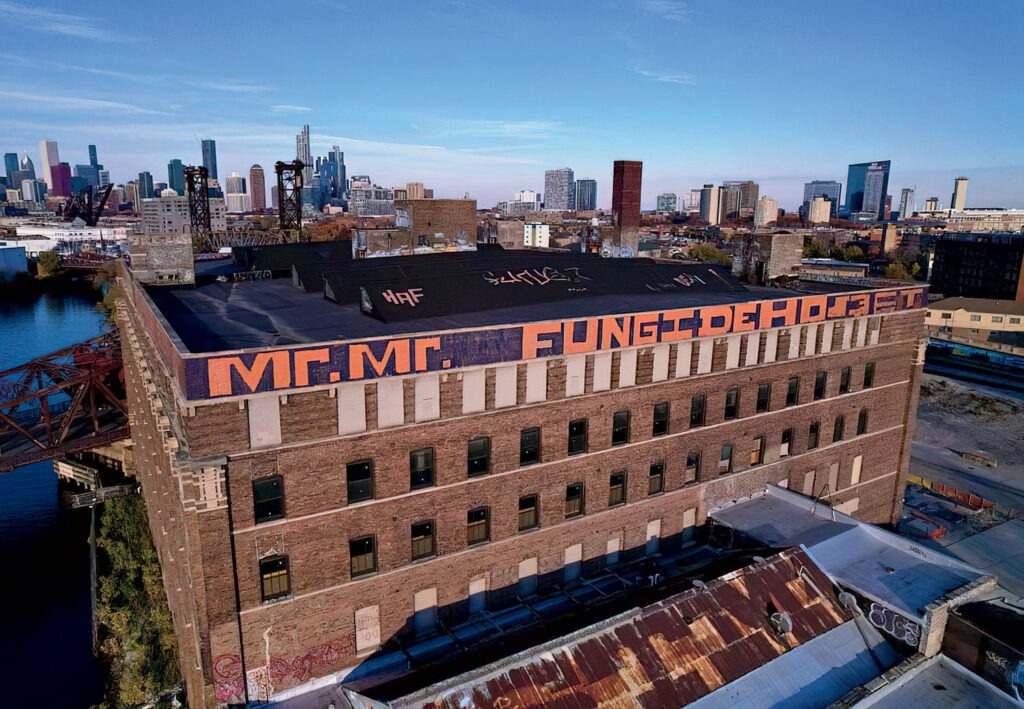
I think of this while watching @fat.pregnant.lady document his daily maleficence. He records himself as he walks into a Starbucks, Beyoncé’s “Halo” playing in the background, grabs someone else’s coffee and pastry bag from the online order section, and walks out. He flashes the name on the order — Aaryn — as he turns down the sidewalk. He always makes sure to show the name of the person whose order he’s stolen; some days he thanks the person. One time, he texted the number on the order, posting a screen grab. The person responded, “Why would you do that?”
It’s the not-normal that keeps me coming back, how it seems to be both an authentic representation of a life and performance art. I write to him every few days, and even though he never responds, I can’t stop checking in.
Tagging breeds a certain sense of anxiety, the street artist Nikko Locander says. “There are a lot of graffiti artists that are so deep in, they’re so paranoid about everything.”
“Hi there! I was wondering if you’d be free to chat sometime this week.”
He disassembles a chainsaw, catfishes a Craigslist listing of Altoids tins.
“I’m pulling together the story about your work and I’d really like to include your voice in the article.”
He posts about his errands: “Probation officer piss test in 45 mins.”
A few days later, my phone buzzes with a message. It’s him.
“I’m sorry. I’m a criminal and I’m very weary [sic] about your credentials.”
I’m not surprised. Locander told me a big reason behind his pivot from graffiti to street art was that he didn’t want to rack up enough offenses to warrant a felony. Tagging breeds a certain sense of anxiety, he says. “There are a lot of graffiti artists that are so deep in, they’re so paranoid about everything.”
Zwon alludes to this during our conversation when I ask him if he knows Mr. Mr. or Fungi. He pauses before responding. “I don’t know them that well,” he says. “I’ve only met Mr. Mr. once. Hung out with Fungi a couple of times. It would be more difficult to get an interview with them. They don’t see any gain in talking to people.”
After this call, Locander introduces me to Milton Coronado, a.k.a. Milt1, another graffiti-artist-turned-street-artist. The main difference between street art and graffiti, he tells me, is that street art leaves a message for the community. “I miss the rush, the adrenaline, everything that came from when I first experienced [graffiti],” he says. “But I look at what I have now at 43 and it doesn’t compare.”
What he has now is a career based, in part, on community healing. He paints murals that honor people who have died, work that connects to the genesis of his career. His mother died when he was 5. “I don’t recall drawing before she died,” he says. “Only after.” In 2016, when he lost his father to gun violence, he painted his portrait, much like the murals he creates today.
Maybe this is the point. Coronado paints to bring people back to life; Zwon, Mr. Mr., Fungi — they paint to give themselves life.
“We could die any day,” Zwon had told me. “If I wouldn’t be doing this, living my regular life, what would stay here after? Nothing would. I’m leaving something behind. It might get painted over, but some might stay.”
Some might stay and some might slowly disappear. The “Mr. Mr. Fungi” on the corner of Western and Irving Park has begun to chip away. Someone has posted a comment on @fat.pregnant.lady’s post from December 24, 2022, a photo of a purple “Mr. Mr. Fungi” on the side of a building: “I live near Western and Irving and my 7 year old daughter always says, ‘When we see “Mr. Mr. Fungi” we know we’re almost home.’ She’s sad to see that one fade. Stay up!!”
I agree. I want it to stay. I want it to remain a marker of my Chicago landscape. Like my first “Mr. Mr. Fungi,” it’s the reason I scan the city for more tags, that I can’t stop wondering, Why “Mr. Mr.”? Why “Fungi”?
“They were friends when I met them,” Zwon says when I continue to press him about Mr. Mr. and Fungi. “I haven’t seen anything new from them for a while. It makes me question if they’re still active. Some people go very hard for a short time, then disappear. There’s no kind of reward for doing graffiti.”
Then, months later, another clue: a pair of photographs on Instagram, from March 2022, taken by Sarah Giroux (@girouxfilms), a cinematographer and, according to her profile, “poolhall junkie.” In one photo, two people stand in an alley underpass holding telescopic paint rollers. In large white letters, one is painting “Mr. Mr.,” the other “Fungi,” faces unseen. The letterforms feel monumental next to their makers. The top section of the last letter of “Fungi” is nearly complete, the roller a speck against a swath of white paint.
I find Giroux’s email address and send her a note asking about the shots. She tells me she ran into the two while taking a shortcut on her way home from City Pool Hall on Hubbard in West Town.
“They were fast at work. I took a quick photo, they stopped, I said, ‘Hey, I’ve seen your work everywhere, super cool!’ They said thanks and realized I wasn’t a threat and kept painting. I snapped one more photo from the other direction and shouted to have a nice day. I heard them say while I was walking away, ‘That was actually cool.’ ”
When I ask Sarah why she thought they let her take their photo, she tells me, “I think it was because I had a genuine reaction of excitement. They saw that I recognized their work and acknowledged how cool it was. I think they were honestly excited to get feedback in the moment from a passerby that their work was not only recognized, but mysterious and unique.”
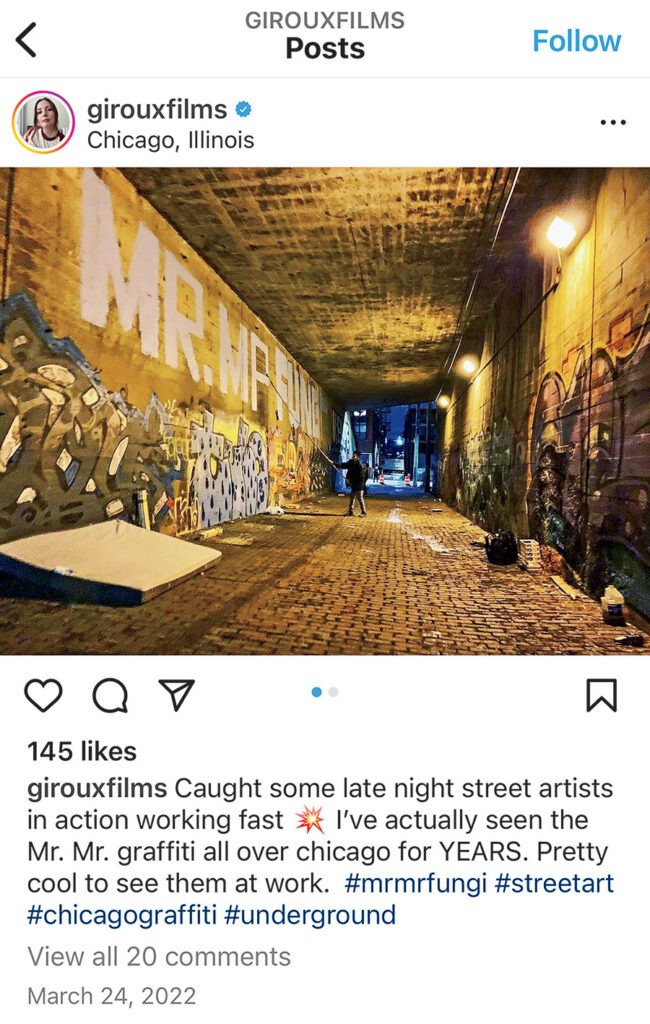
I scan the comments on her Instagram post. One stands out as immediately dismissive:
alexlakin_dp: Defacing public property is a crime, that’s why they’re working fast. Next time I’d confront them Sarah
Toward the end of a long string of replies to the comment, a familiar handle emerges.
fat.pregnant.lady: @alexlakin_dp for your own personal safety, confronting us is probably the last thing you’d want to do.
I look back at the last direct message I sent to @fat.pregnant.lady, weeks earlier: “But can I ask you a question here? Why Fungi?”
I didn’t expect a response, and I didn’t get one. But a few days later, after he’d posted nothing but stories for nearly six months, I see @fat.pregnant.lady in my Instagram feed. There is a drawing of his cat. A skeleton and a skateboard. And then, one after another, overexposed photos that suggest a flash in complete darkness, paint on brick, on metal, on concrete: “Fungi.” “Fungi.” “Fungi.” “Fungi.”
It’s how I’ve felt writing this story — in the dark, trusting my gut that I’m chasing something tangible. Scraps of information casting enough of a glow, like car lights or street lights, to keep me focused on what’s in front of me: a graffiti artist who’s everywhere, but nowhere. A guy who lets you watch his life as @fat.pregnant.lady, but refuses to talk.
And then finally, after months of searching, he’s there, sitting right across from you at a coffee shop, wearing a black ski mask. Fungi in the flesh.
“I’m here for an interview,” he had told a barista as he walked in, before I slid out of the booth to introduce myself. “I’m — I’m here for an interview, not to rob the place. …” His voice trailed into something more sheepish than I’d anticipated.
Sitting here, he seems young, maybe in his late 20s, but I can’t tell for sure. I notice that his hands are callused, with dirt under his fingernails, like he’s just come from working on something.
We’re at the Brewed Coffee on Milwaukee in Avondale (his choice). In addition to the ski mask, he’s wearing a cream hoodie and a black Carhartt jacket, splattered with white paint — a coat that looks remarkably similar to the one I saw in a mug shot that showed up in a records search I performed on the guy mentioned in the Berwyn arrest article. Later, when we talk about protecting his identity — he agreed to meet only if I wouldn’t mention his name in my story — he shrugs and says, “Well, it’s not that hard to look up ‘fungi graffiti’ on Google.”
Days earlier, after months of silence, I had gotten a DM from @fat.pregnant.lady: “I talked to Swon [sic] and he eased my anxiety. When ya free next?”
We had arranged to meet on this Thursday afternoon in November. I order a hot chocolate, and he gets a cold brew (my treat). We start with the last question I asked him on Instagram: Why “Fungi”?
“We can attribute this conversation to whomever,” I add. “Fungi, @fat.pregnant.lady —”
“No,” he interrupts me. “That wouldn’t be appropriate,” he says, referring to his Instagram handle. There’s a politeness that I wasn’t expecting. He talks quickly, with a strong Chicago accent. He shifts his weight, leans back into the booth, rests his elbows on the table.
“I’m nervous,” he says as we sit under the watchful gaze of a large wooden Frankenstein face on the wall. I am too.
It turns out his signature tag is an homage of sorts to an interest in mushrooms that began in the seventh grade, in Miss Q’s science class (“It was actually one of the first drugs I tried”). Now it’s an apt metaphor for how Fungi thinks of graffiti, how it builds on something old, transforms it into something different: “Mushrooms are kind of interesting to me because they grow off of decay and a lot of times that kind of plays into the world of graffiti. There’s a whole dynamic and politics with graffiti, especially in the city here. The old heads hate on the new young up-and-comers. So it’s kind of like a new surface growing on the old surface.”
Plus, the play on words. “ ‘Fungi,’ like ‘fun guy,’ ” he says, smiling.
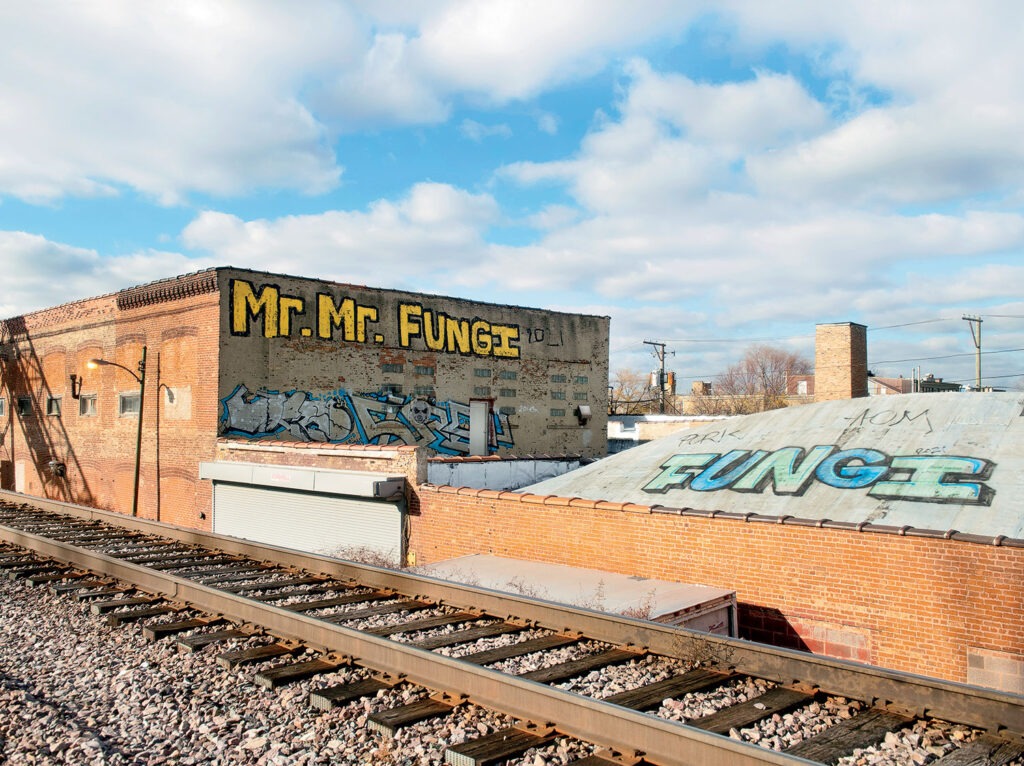
How’d he start collaborating with Mr. Mr.? “Oh yeah. So he’s just a roller guy” — meaning that instead of tagging with spray paint, he uses rollers and paint to make large-scale pieces. Apparently you don’t need spray paint to create some of the most recognizable graffiti in Chicago.
“Go to Home Depot and get the latex paint. We got some super-long extension poles, and we figured out how to get up on rooftops. We used the roller pole to pull down the fire escape, get up on the roof, then hang over.”
Latex gives you bigger quantities for cheap, compared with spray paint. “Usually it takes about two gallons per name, depending on how big it is. And sometimes the wall is super fragile — it’s cracking. You could touch it and the mortar’s coming out. So you really have to slap it on.”
The trick, he tells me, is peeing in the paint to get it to stick. “Or pour in your beer, or whatever. I guess the theory is it’s supposed to make the paint stain harder.”
He met Mr. Mr. because of a friendly competition Fungi had with a guy in San Diego. They wanted to see who could do 50 rollers before the end of the year. “I was getting up to 35, and then when we were going out with our friends, I met Mr. through a series of people. We were going into abandoned buildings and stuff like that.”
The abandoned buildings are an important detail. In fact, as we talk, I learn that the two painted a lot on abandoned buildings because that’s one way to “fight the buff” — to make it less worth the city’s time and resources to buff out, or remove, their work.
Fungi says he’s originally from a south suburb, but he now lives in Chicago. These days, he’s dabbling in different art projects, taking a break from graffiti because he’s on probation. Instead, he makes latex masks, stained glass (he wants to create something nice for his parents for Christmas that will fit in their picture window), and go-carts. The chainsaw I had seen on his Instagram? Turns out it was a Halloween prop. He doesn’t go into detail on the record about why he was arrested, but it has something to do with filling fire extinguishers with watered-down paint so he could hit spots high enough that buffing out his work would be difficult.
“I did a really good job of paying everything off. My pee tests are coming back clean,” he says with a laugh.
The brashness I saw on Instagram is missing in person. He speaks with more levity and has more curiosity and delight in the unknown than I was expecting. Even the ski mask (which stays on the entire time) feels more like an intentional element of his own myth building than a reflection of fugitive status.
Toward the end of our conversation, when I ask him if there’s anything we haven’t talked about that we should, he says, “I was really hoping you’d ask me about my spaghetti policy.” Smiling, he reaches into his pocket and pulls out a large ziplock bag filled with cooked noodles and red sauce. It’s hard not to laugh. Even in real life, there seems to be an element of performance.
Fungi tells me he no longer paints with Mr. Mr. Their split had to do with local graffiti politics. Turns out Fungi was in a crew. Two, actually. He started off in one called TNF, which he dropped out of when he didn’t see it going anywhere. “It’s a group chat of young kids talking bullshit. And the leader was doing it just to be a crew leader, you know what I mean?” Fungi felt like a toy — a derisive label in the graffiti world for someone inexperienced or unskilled — and he didn’t want any part of that.
He left to join another crew, AOM (Against Our Mayor), made up mostly of older guys (“gentlemen,” he says), figuring he’d been brought on because he’d be able to continue their work. When he left TNF, other artists left, too, and it caused trouble with the remaining crew members. “They’re messaging me, they tell me they’re coming to my house. They tag the outside of my apartment.”
They found out where Mr. Mr. worked and told him that they’d come to his job if he continued to paint with Fungi. Mr. Mr. decided he didn’t want to be involved with Fungi anymore. “I mean, he’s still doing his thing. I haven’t talked with him, but I heard through the grapevine that he’s still exploring abandoned buildings and throwing up his single lines.”
I ask him if he misses doing rollers with Mr. Mr. “Yeah.” He pauses. “We would go out until like 2 or 3 in the morning, just drinking and painting and having a good old time. I miss the boys. But a lot of times with graffiti, you deal with criminals, and when you deal with criminals, there’s drugs. People start to go on their own ways.” He sips his coffee.
“We’d meet up at my house, pregame, get everything set up. Mr. was the designated driver — that’s why he was mostly always there, I mean. But you know, one hand washes the other hand. He wasn’t always just driving. I’d be supplying him paint. We’d smoke him out. It was never one-sided.”
The way he talks about how it used to be reminds me of decay. Of new growing off the old, only to inevitably crumble and make way for something else. Fungi isn’t painting right now. He will again, once his probation is over, but not with his old partner. Which raises the question: What happens to Fungi without Mr. Mr.? What if people still think they’re the same guy, like I once did?
“Well, I think it’d be cool. If you see Mr. Mr., you’ll think of Fungi. You see Fungi and you’ll think of Mr. Mr., and that’s what I was trying to aim for, but it’s like that saying that nothing good lasts forever. It’s a huge lesson I’ve learned in life — take advantage of what you have now.”
Before he leaves, Fungi tells me about a piece he and Mr. Mr. have on an abandoned building near the Costco in Lincoln Park, on Clybourn and Diversey. It’s green, right above a fence. “It’s beautiful,” he says. “The city couldn’t buff it out, didn’t want to spend money getting vehicles up that high, so they’ve put a tarp over it. I want to go back up there. Go up on a ladder and just cut it off.”
I tell him I’ll look for the tarp. Even if I can’t see their tag, just knowing that it’s there is almost enough. Especially since Mr. Mr. Fungi no longer exists. I hope I’ll see a fresh “Fungi” when the time is right — when the days of pee tests and graffiti politics are over.
But that’s the thing about mushrooms. About fungi. They don’t need much, not even light, to pop up in the most unlikely places.



